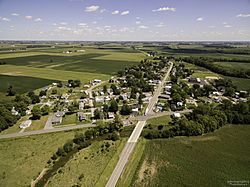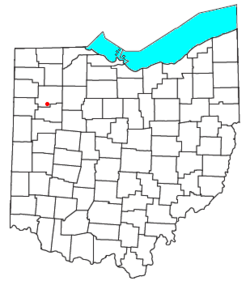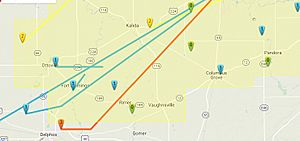Vaughnsville, Ohio facts for kids
Quick facts for kids
Vaughnsville, Ohio
|
|
|---|---|

Aerial view of Vaughnsville
|
|

Location of Vaugnsville, Ohio
|
|
| Country | United States |
| State | Ohio |
| County | Putnam |
| Township | Sugar Creek |
| Elevation | 768 ft (234 m) |
| Population
(2020)
|
|
| • Total | 278 |
| Time zone | UTC-5 (Eastern (EST)) |
| • Summer (DST) | UTC-4 (EDT) |
| ZIP |
45893
|
| GNIS feature ID | 2628982 |
Vaughnsville is a small community in Putnam County, Ohio, United States. It is known as an unincorporated community and a census-designated place. This means it's a recognized place but doesn't have its own city government.
Vaughnsville is located in southern Sugar Creek Township. It has a post office with the ZIP code 45893. The community sits where State Route 115 meets State Route 12 and State Route 189. In 2020, about 278 people lived there.
History of Vaughnsville
Vaughnsville has an interesting past, including a unique invention and its connection to early transportation.
How Vaughnsville Got Its Name
The community was first named Monterey. It was officially started in 1847. Later, a man named Daniel C. Vaughn added more land to the town. He then gave the town his own name, Vaughnsville. A post office has been open in Vaughnsville since 1848.
A Unique Invention: Individual Communion Cups
Vaughnsville is famous for being the first place in the world to use individual cups for communion. This is a special part of a church service. A doctor and pastor named John G. Thomas was from the Vaughnsville Congregational Church. He noticed someone with a mouth condition during a service.
To help with hygiene, he designed a new communion set. He applied for a patent for his invention in 1893. A patent is a special right given to an inventor. His idea was to have a separate cup for each person. The church first tried these cups in 1893. The patent was officially given to him in 1894. This was the first time individual communion cups received a patent in the U.S. Thomas later started the Thomas Communion Service Company.
Railroads and Early Roads
For many years, the Northern Ohio Railroad had a station in Vaughnsville. This station handled both passengers and goods. It also had a telegraph office. Later, the Akron, Canton and Youngstown Railroad bought the Northern Ohio Railroad.
Trains on this line were sometimes called the "Delphos Bullet." These trains carried both freight and people. They traveled 165 miles from Akron to Delphos. The last trip for this type of train was on July 20, 1951. It was the last mixed-use train in Ohio. The train tracks were removed completely in the 1980s.
Early Businesses and Development
The first grist mill in the county was built in 1831. A grist mill grinds grain into flour. Benjamin Clevenger built it on the east bank of Sugar Creek, where Vaughnsville is now. In 1832, Clevenger also built a road from Vaughnsville to Lima.
After the Civil War, the first stone road was built in Sugar Creek Township. Today, this road is State Route 115. By 1915, Vaughnsville had a bank, an elevator for grain, a saw-mill, and a grocery store.
Vaughnsville School History
Vaughnsville had its own middle and high school for many years. The original school building was constructed in 1908. It cost $15,000 to build. In 1915, an addition was made to the school, which doubled its size. This addition cost $11,000. In 1962, the Vaughnsville school joined with the school in Columbus Grove.
Geography of Vaughnsville
Vaughnsville is located in an area with specific soil types and a certain climate.
Soil and Farming
The soil in Vaughnsville is mostly a type called Vaughnsville loam or Hoytville-Napanee. This soil is found near old glacial lake beaches. It warms up quickly in the spring and is easy to work with. This soil is usually neutral or slightly acidic. Water drains slowly to moderately from it. This type of soil is excellent for farming if it is drained well. Farmers often grow corn, soybeans, and small grains here.
Plant Hardiness Zone
Vaughnsville is in USDA Plant Hardiness Zone 6a. This zone helps gardeners know which plants can survive the winter temperatures. In Zone 6a, the lowest winter temperatures are usually between -10 and -5 degrees Fahrenheit. The most common trees in the area are ash, hickory, sugar maple, Northern red oak, and red maple.
Local Rocks
The rocks under the ground in Vaughnsville are mainly Silurian dolomite and shale. Dolomite is a type of rock similar to limestone. Shale is a soft rock made of clay.
Land Shape
Vaughnsville is about 761 feet (232 meters) above sea level. The land around the community is mostly flat.
Climate in Vaughnsville
Vaughnsville has a humid continental climate. This type of climate has cool to cold winters and humid, hot summers. It is found only in the Northern Hemisphere.
Temperature and Precipitation
Vaughnsville gets about 35 inches (886 mm) of rain each year. The average temperature is about 49.6 degrees Fahrenheit (9.8 degrees Celsius) per year. On average, Vaughnsville has 180 sunny days each year. There are about 114 days with some measurable rain or snow.
The average high temperature in July is around 84 degrees Fahrenheit. The average low temperature in January is 18 degrees Fahrenheit. The most rain ever recorded in one day was 8.14 inches on August 19, 2007. The hottest temperature ever recorded was 109.04 degrees Fahrenheit on July 14, 1936. The coldest temperature ever recorded was -23.08 degrees Fahrenheit on February 26, 1963.
Record High Temperatures By Month
| Month | Record High | Record High Date |
|---|---|---|
| January | 77.0° | January 21, 1906 |
| February | 73.0° | February 25, 2000 |
| March | 86.0° | March 21, 2012 |
| April | 90.0° | April 29, 1899 |
| May | 96.1° | May 17, 1962 |
| June | 102.9° | June 25, 1988 |
| July | 109.0° | July 14, 1936 |
| August | 104.0° | August 27, 1948 |
| September | 100.9° | September 15, 1939 |
| October | 93.0° | October 3, 1898 |
| November | 79.0° | November 1, 1933 |
| December | 71.1° | December 2, 1982 |
Record Low Temperatures By Month
| Month | Record Low | Record Low Date |
|---|---|---|
| January | -20.9° | January 19, 1994 |
| February | -23.1° | February 26, 1963 |
| March | -13.0° | March 9, 1984 |
| April | 6.1° | April 7, 1982 |
| May | 25.0° | May 7, 1974 |
| June | 36.0° | June 2, 1910 |
| July | 41.0° | July 10, 1898 |
| August | 36.0° | August 29, 1965 |
| September | 24.1° | September 29, 1893 |
| October | 15.1° | October 30, 1895 |
| November | -2.9° | November 30, 1958 |
| December | -18.9° | December 22, 1989 |
Monthly Averages & Records (1981-2010)
| Date | Average
Low |
Average
High |
Average
Precipitation |
Average
Snow |
| January | 18° | 33° | 2.22" | 3.7" |
| February | 22° | 37° | 1.98" | 4" |
| March | 30° | 48° | 2.68" | 1.4" |
| April | 39° | 60° | 3.46" | 0.8" |
| May | 50° | 72° | 3.89" | NA |
| June | 59° | 80° | 4.05" | NA |
| July | 63° | 84° | 4.26" | NA |
| August | 62° | 81° | 3.38" | NA |
| September | 55° | 76° | 3.07" | NA |
| October | 44° | 64° | 2.41" | 0.1" |
| November | 34° | 50° | 3.12" | 0.6" |
| December | 24° | 38° | 2.68" | 3.2" |
Record Daily Precipitation Records
| Date | Maximum Precipitation |
|---|---|
| August 19, 2007 | 8.14 in. |
| August 21, 2007 | 6.19 in. |
| July 8, 1997 | 4.91 in. |
| August 16, 1997 | 4.85 in. |
| June 14, 1981 | 4.16 in. |
Severe Weather in Vaughnsville
The National Weather Service offices in Northern Indiana and Wilmington, Ohio, cover Vaughnsville. They use radar from North Webster to track weather. The closest weather station is at Lima Allen County Airport.
On June 29, 2012, a powerful storm system called a derecho hit the area. A derecho is a widespread, long-lived wind storm. It caused a lot of damage from Findlay to Marion to Mount Vernon. Many trees and some barns around Vaughnsville were damaged.
No tornadoes have directly hit Vaughnsville in recorded history. The closest tornado was an F0 tornado southwest of the community on June 8, 1993.
See also
 In Spanish: Vaughnsville (Ohio) para niños
In Spanish: Vaughnsville (Ohio) para niños




